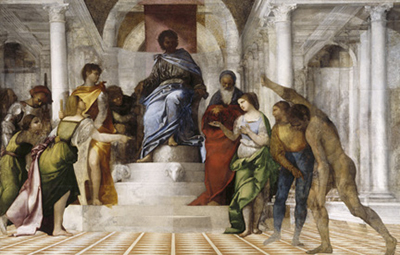The Judgement of Solomon ranks as one of artist Sebastiano's biggest projects and was intended for installation within a prominent spot in a grand palace
The underlying theme behind this biblical story is that of truth, as two mothers clash over their respective babies. The artist took this particular inspiration from (1 Kings 3: 16–28) in the old testament. Throughout the Renaissance, of course, religion was present in the majority of paintings which reflected its significant role in society more generally.
The dispute over who is the rightful mother of the living baby is decided by Solomon, whilst the executioner looks on awaiting instruction. Several key elements of this painting were sadly left incomplete but we know what was to be added by studying the original story and reflecting on other artist's depictions of the same theme.
The painting is dated at around 1509, meaning the artist was in his mid-twenties when working on it. This explains why it was originally attributed to Giorgione, as in this early stage he still possessed a particularly Venetian style of art. It was only later that the influence of Rome would start to appear, partly through the more sombre colour schemes that he would now use. You will see this variety across his paintings page.
The scene features the false mother accusingly pointing at the real mother, just before being exposed by a calculating Solomon who successfully identifies the true mother. Parts of the composition, when examined up close, had still not been decided upon by the artist with several options still faintly visible. Despite this lack of completeness, it is still a highly signficant painting within Sebastiano's career because of its grand size and the prominence of its intended destination.
Mauro Codussi had designed a new palace for Andrea Loredan and had intended for Sebastiano to produce the most ambitious painting of his career to date. In fact, the size at that time would rival anything seen from any member of the Venetian School up to the early 16th century. The other members of this prestigious group of artists included Titian, Lorenzo Lotto, Correggio, Giorgione, Tintoretto and Giovanni Bellini.




